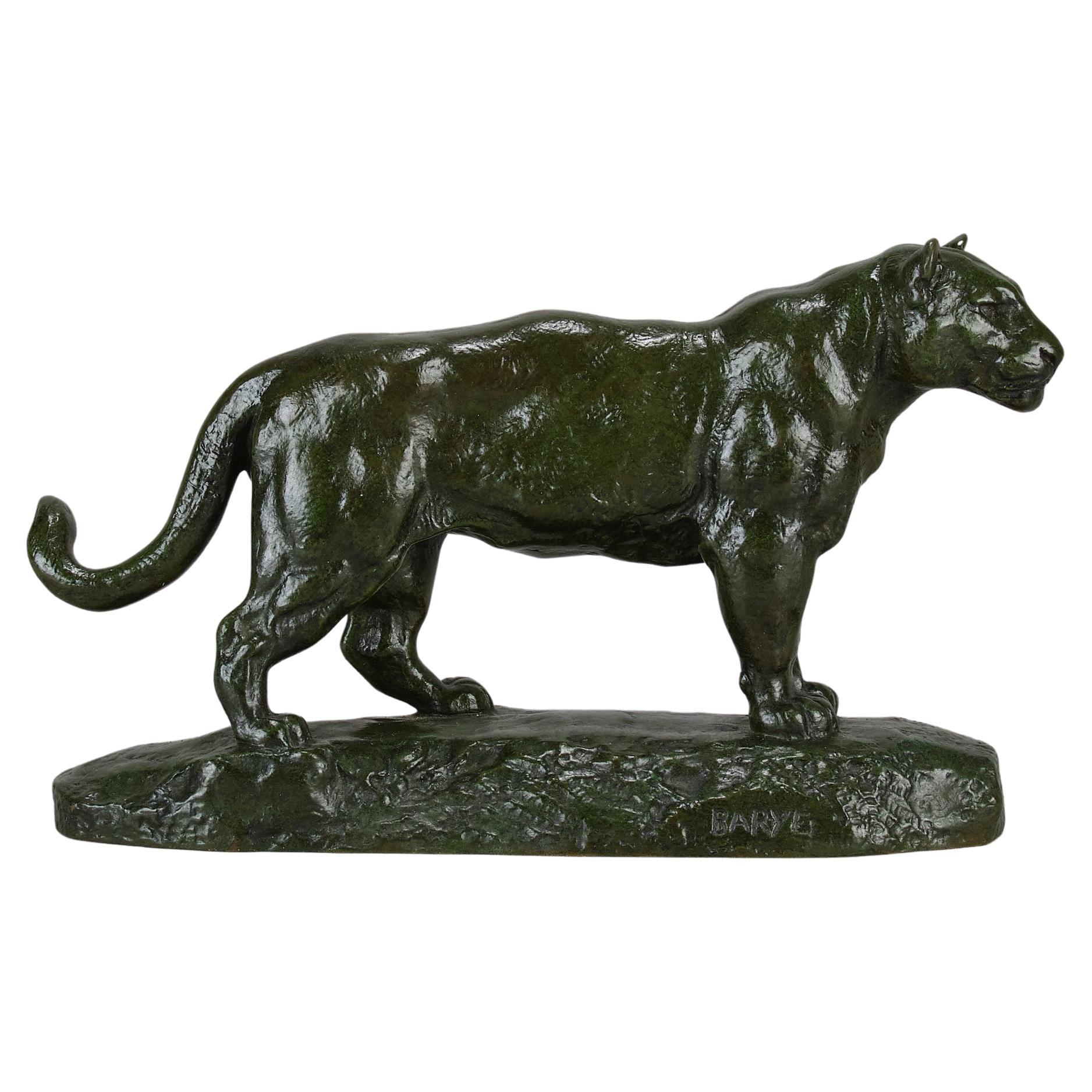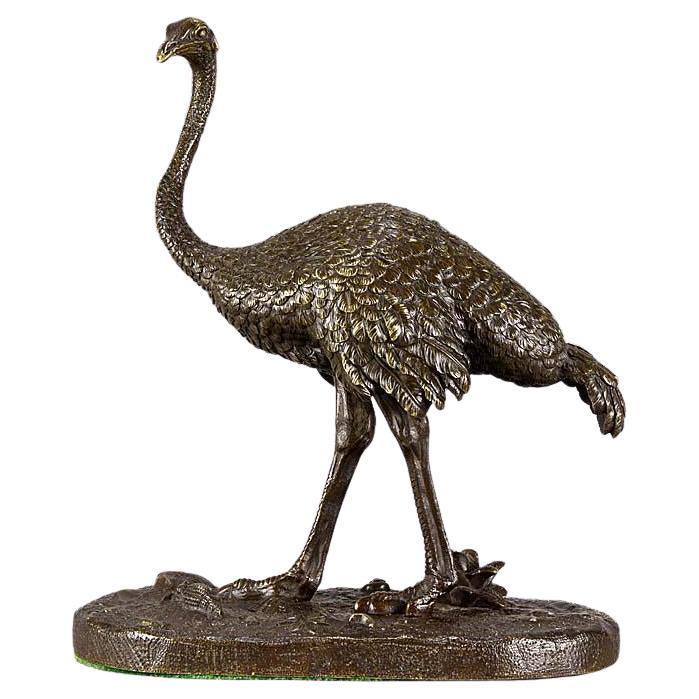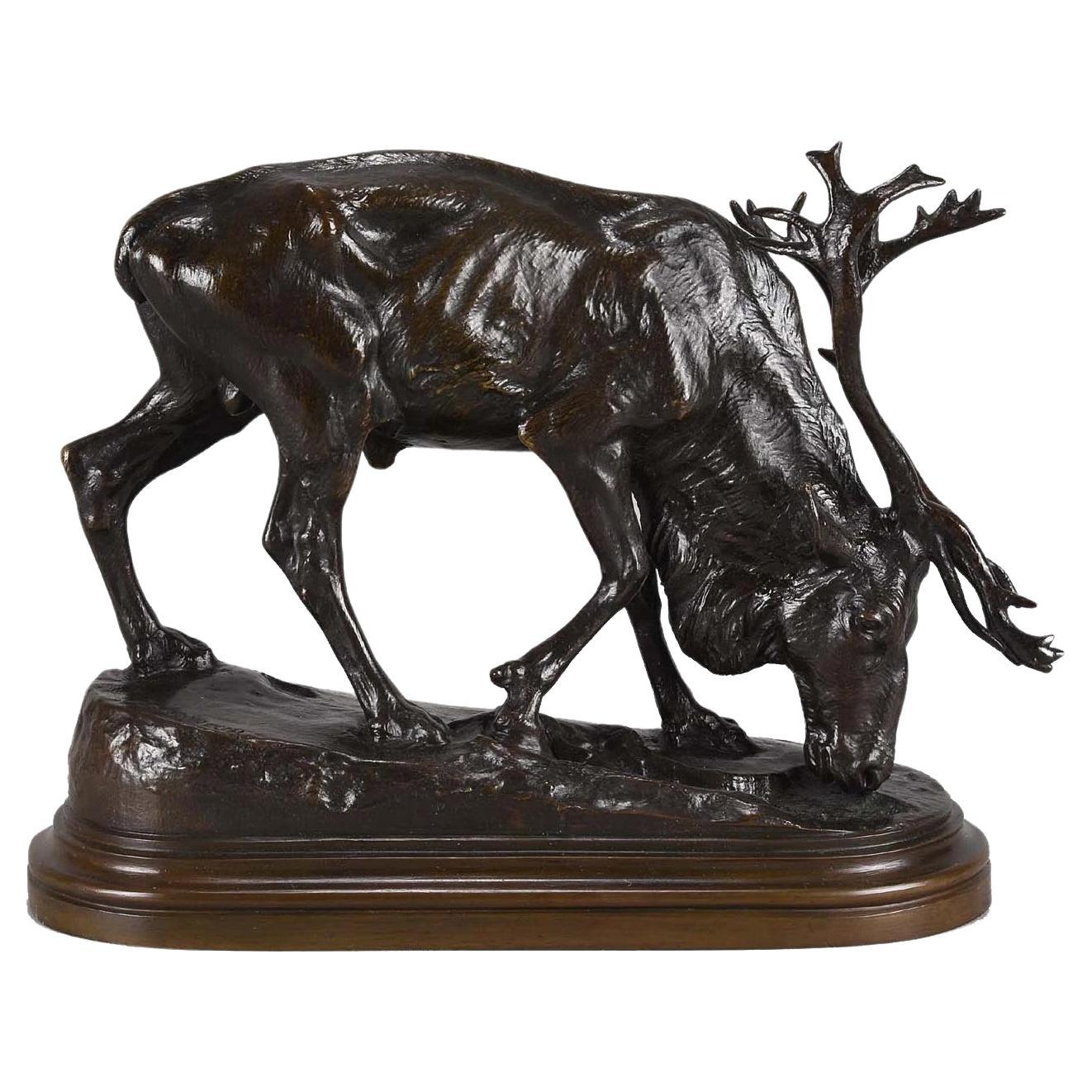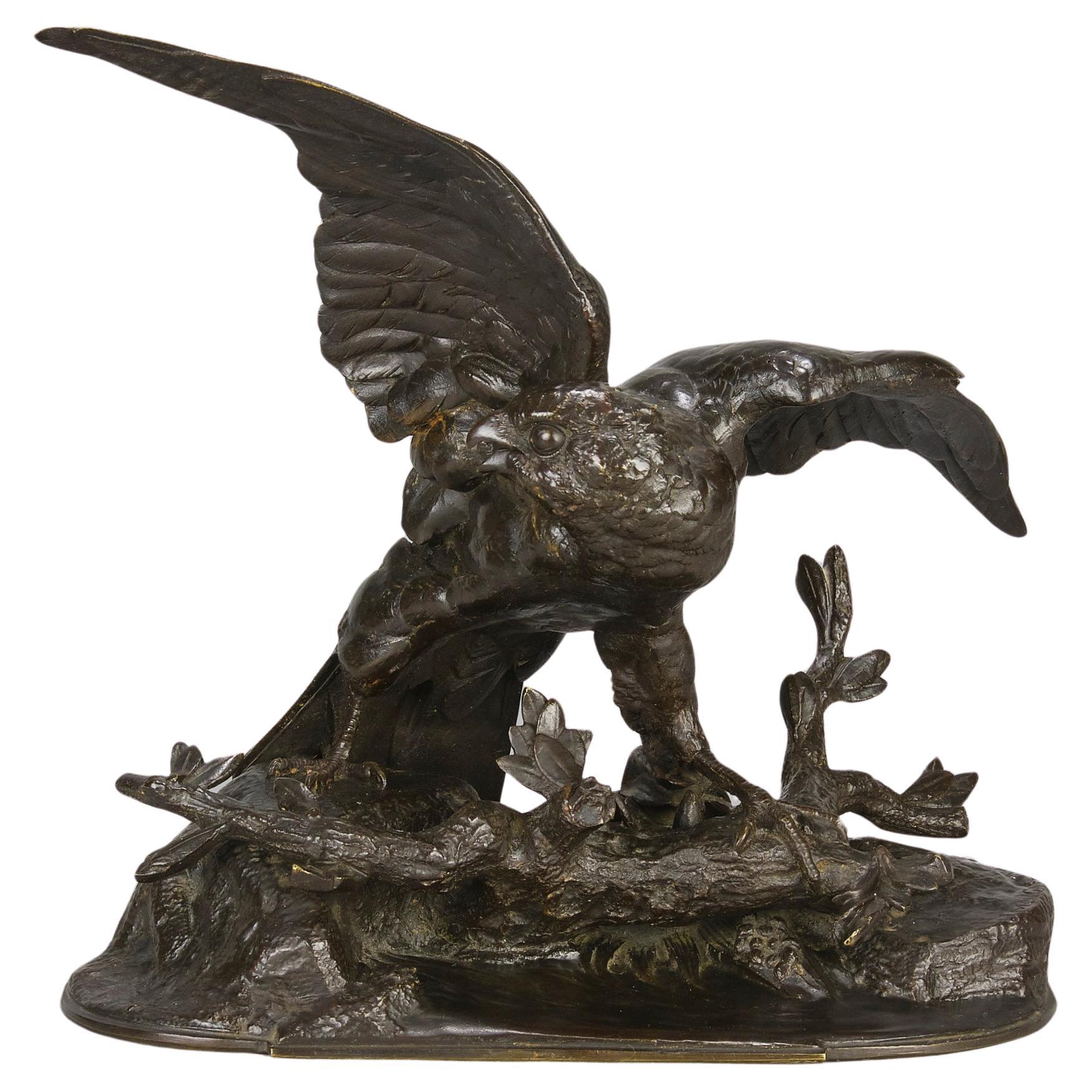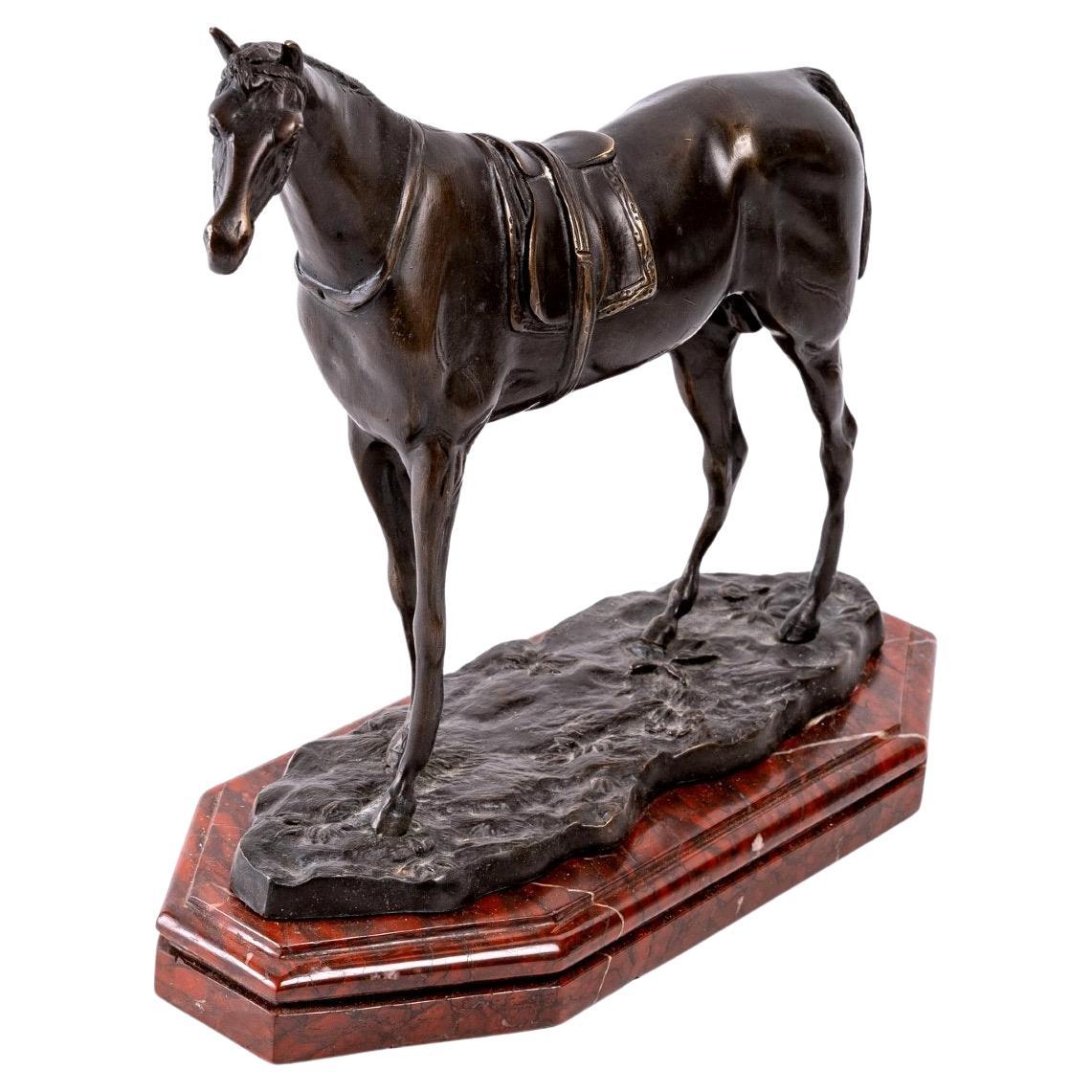Items Similar to 19th Century Animalier Bronze Study Entitled "Tired Hunter" by John Willis-Good
Want more images or videos?
Request additional images or videos from the seller
1 of 12
19th Century Animalier Bronze Study Entitled "Tired Hunter" by John Willis-Good
About the Item
An excellent late 19th century English Animalier bronze study of a tried hunter in full tack taking a break with his neck turned and back leg rested. The bronze exhibiting very fine hand chased surface detail and wonderful rich brown patina, raised on a naturalistic oval base, signed J Willis Good
Additional Information
Height: 29 cm
Width: 43 cm
Condition: Excellent Original Condition
Circa: 1870
Materials: Bronze
About
Willis-Good Bronze
John Willis-Good, British 1845 ~ 1879 - Considering that the British have long been regarded as a nation of animal-lovers it is somewhat surprising that comparatively little Animalier sculpture was produced in the United Kingdom. There was a demand for the new sculpture movement that had become very substantial and a highly lucrative trade that was established with the import of French bronzes into Britain. spite this there are a few examples of British Animalier sculptors who were at work in the 19th Century. Outstanding among them is the charismatic figure of John Willis Good who exhibited at the Royal Academy between 1870 and 1878. Little is known about him except that he specialised in bronze and terracotta statuettes of race-horses, hunters and dogs. During the nine year period in which he exhibited at the Royal Academy he showed some sixteen statuettes of race-horses and jockeys.
- Creator:John Willis Good (Artist)
- Dimensions:Height: 11.42 in (29 cm)Width: 16.93 in (43 cm)Depth: 0 in (0.01 mm)
- Style:Art Nouveau (Of the Period)
- Materials and Techniques:Bronze,Cast
- Place of Origin:
- Period:
- Date of Manufacture:1870
- Condition:Wear consistent with age and use. Excellent. Excellent Original Condition Please note that our items are genuine antiques with considerable age. It is therefore normal that they will show some signs of wear and handling to the surface.
- Seller Location:London, GB
- Reference Number:
About the Seller
5.0
Gold Seller
These expertly vetted sellers are highly rated and consistently exceed customer expectations.
Established in 1936
1stDibs seller since 2017
64 sales on 1stDibs
Typical response time: <1 hour
- ShippingRetrieving quote...Ships From: London, United Kingdom
- Return PolicyA return for this item may be initiated within 10 days of delivery.
More From This SellerView All
- 19th Century Animalier Bronze Study entitled "Jaguar Debout" by Antoine L BaryeBy Antoine-Louis BaryeLocated in London, GBAn impressive late 19th Century Animalier bronze study of a standing panther with excellent rich green patina and very fine hand chased surface detail. Raised on an integral base, si...Category
Antique Late 19th Century French Art Nouveau Animal Sculptures
MaterialsBronze
- 19th Century Animalier Bronze Sculpture entitled "Standing Ostrich" by BaryeBy Alfred BaryeLocated in London, GBA very rare late 19th Century French Animalier bronze study of a standing ostrich, the detailed feathering chased with extremely fine precision, the flightless giant bird...Category
Antique 19th Century French Art Nouveau Animal Sculptures
MaterialsBronze
- 19th Century Animalier Bronze Sculpture Entitled "Reindeer" by Isidore BonheurBy Isidore Jules BonheurLocated in London, GBExcellent late 19th century animalier bronze study of a feeding reindeer with rich brown colour and very fine hand chased and etched surface detail, raised on a stepped naturalistic base, stamped with Peyrol Foundry mark and signed Isidore Bonheur Additional information Height: 16 cm Width: 22 cm Condition: Excellent Original Condition Foundry: Peyrol circa: 1880 Materials: Bronze SKU: 8211 DESCRIPTION Isidore Bonheur Isidore Bonheur, born in Bordeaux May 15 1827. Isidore was the third child of Christine Dorotheé Sophie Marquis (1797–1833), a musician, and Oscar-Raymond Bonheur (1796–1849) (a landscape and portrait painter and an early adherent of Saint-Simonianism, a Christian-socialist sect that promoted the education of women alongside men). Isidore was the brother of Auguste Bonheur...Category
Antique Late 19th Century French Art Nouveau Animal Sculptures
MaterialsBronze
- 19th Century Animalier Bronze Sculpture entitled "Falcon" by Jules MoigniezBy Jules MoigniezLocated in London, GBAn excellent mid 19th Century French Animalier bronze study of a falcon perched on a branch using its outspread wings to balance and with its beak open. The bronze exhibiting excellent intricate hand chased surface detail and very fine rich brown lightly rubbed patination, signed J Moigniez. ADDITIONAL INFORMATION Height: 23 cm Width: 23 cm Condition: Excellent Original Condition Circa: 1870 Materials: Bronze Book reference: Animals in Bronze by Christopher Paine Page no. 79 SKU: 9000 ABOUT Jules Moigniez (French, 1835 ~ 1894) Moigniez was a French animalier sculptor of the 19th century. He worked primarily in bronze and frequently exhibited his sculptures at the Paris salon. He was best known for his bronzes depicting birds, although his skill and versatility enabled him to produce quality horse sculptures (primarily racehorses), dog sculptures and hunting scenes. His bird sculptures were among the finest ever created in his time. Moigniez was born at Senlis, Oise, France in 1835, the son of a metal gilder. Moigniez’s father bought a foundry to cast his sculptures, which was of great benefit to Moigniez as he didn’t have the added foundry costs that most of his contemporaries had to pay. Moigniez studied sculpture under the tutelage of Paul Comoléra (a student of François Rude) in Paris. It is quite likely that Moigniez’s attraction to bird sculpture was a direct result of his education under Comoléra, who was himself a bird specialist. Over the course of his 40-year sculpting career Moigniez exhibited thirty works at the Salon between 1855–92. His first submission in a major art exhibition was his plaster, Pointer Stopping at a Pheasant, at the Exposition Universelle of 1855.[1][2] Moigniez was known for the fine detail and chiseling of his sculptures. His bronzes—usually cast using the lost wax method—were always immaculately chased and patinated, and were especially popular in England and Scotland.[2] More than half of his output during his lifetime was sold in the United Kingdom. By the end of the 19th century, his sculpture had become popular in the United States as well. In contrast with other animaliers of the period such are P.J. Mêne and Antoine-Louis Barye, Moigniez’s bird sculptures often incorporated highly detailed bases complete with bushes, extensive foliage and undergrowth. His castings were generally of excellent quality with a variety of patinas, the gilded and silvered patinas being the most desirable and sought after by collectors. His bronzes could be reproached for an excess of detail, a result of overly-finicky, over-worked chiseling. Moigniez received redemption, however, by portraying in his sculpture a certain “elegance of attitudes”. His Chien braque...Category
Antique Mid-19th Century French Art Nouveau Animal Sculptures
MaterialsBronze
- 19th Century Animalier French Bronze Entitled "Taureau Debout" by Rosa BonheurBy Rosa BonheurLocated in London, GB"Taureau Debout" by Rosa Bonheur. An excellent late 19th Century French animalier bronze study of a standing bull with fine hand chased surface that accentuates the muscle definition of the subject, signed Rosa B. ADDITIONAL INFORMATION Measures: Width: 32 cm Height: 18 cm Depth: 11cm Condition: Excellent Original Condition Circa: 1870 Materials: Bronze Book reference: Animals in Bronze by Christopher Payne Page no. 174 DESCRIPTION Bonheur, Rosa (1822-1899) The most popular artist of nineteenth-century France, Rosa Bonheur was also one of the first renowned painters of animals and the first woman awarded the Grand Cross by the French Legion of Honor. A professional artist with a successful career, Bonheur lived in two consecutive committed relationships with women. Born on March 16, 1822 in Bordeaux, Marie Rosalie Bonheur was the oldest of the four children of Raimond Oscar Bonheur (1796-1849) and Sophie Marquis. Bonheur's father was an art teacher who came from a poor family, while her mother, a musician, had descended from a middle-class family and had been her husband's art student. Bonheur's father, who taught drawing and landscape painting, was an ardent member of the utopian Saint Simeon society. The group held idealistic beliefs about the reform of work, property, marriage, and the role of women in society. Most importantly, for the artist's future, the Saint Simeons questioned traditional gender norms and firmly believed in the equality of women. While teaching artistic techniques to his oldest daughter, Raimond Bonheur also encouraged her independence and taught her to consider art as a career. In 1828 Raimond Bonheur joined the Saint Simeons at their retreat outside Paris. Sophie and the children joined him in Paris the following year. Four years later, however, Raimond abandoned his family to live in isolation with his fellow Saint Simeons. Sophie Bonheur died in 1833 at the age of thirty-six. Rosa was only eleven years old when her mother died, but she was aware of the heavy price her mother paid for married life with a man who was more dedicated to his own ideals than to meeting his family's needs. Rosa also saw that her mother's marriage led to poverty and her death from exhaustion. After her mother's death, Bonheur was taken in by the Micas family who resided nearby. Mme Micas and Bonheur's mother had been friends. When Mme Bonheur died, the Micas family paid Raimond Bonheur's debts and cared for Rosa. Their daughther, Nathalie, who would later become an amateur inventor and unschooled veterinarian, and Rosa became enamored with each other. When Rosa Bonheur began her career as a professional artist, she had already been trained by her father who had allowed her to study in all male classes. Rosa also learned by sketching masterworks at the Louvre from the age of fourteen, and later, by studying with Léon Cogniet. From the very beginning, Bonheur's favorite subject was animals. She learned their anatomy completely by dissecting them in local slaughterhouses. She also visited the horse market two times a week. Study of animals by direct observation led to the formation of the realist style in which Bonheur worked. It was for such work that Bonheur obtained written permission from the French government to wear men's slacks. Her working attire also consisted of a loose smock and heavy boots that protected her feet from the dangerous environment in which she painted. The style of dress that the artist adopted for work and home may well have been influenced by her father's attire, which was based on St. Simeonian clothing experiments. Bonheur also cropped her hair, perhaps to facilitate her work. She did, however, always wear dresses for social occasions because she knew that appropriate dress would further her career. Bonheur earned a successful living as a painter of animals. She exhibited at the annual Paris Salon regularly from the age of nineteen in 1841 through 1853, when she was thirty-one. She won the salon's gold medal at the age of twenty-six in 1848 and was commissioned by the French government to paint Plowing on the Nivernais in 1849. In the same year Bonheur and her sister Juliette became directors of l'École gratuite de dessin pour les jeunes filles, a post their father had once held. Bonheur completed her most renowned work, The Horse Fair, in 1855. The successful representation of percherons (a breed native to Normandy) was purchased by Ernest Gambart, a London art dealer whose gallery specialized in work by French artists. He exhibited The Horse Fair in London where Bonheur visited with Nathalie. Queen Victoria requested a private viewing of the painting at Windsor Castle. It would later be purchased in 1887 by Cornelius Vanderbilt and donated to the new Metropolitan Museum of Art in New York City. Bonheur's trip to England allowed her to meet Charles Eastlake, then President of the Royal Academy, John Ruskin, the English writer and critic, and Edwin Landseer, the British animalier. She also toured the English and Scottish countrysides and executed some paintings based on her observations of new breeds of animals found there. Gambart made engravings of Bonheur's work, including The Horse Fair, and sold them in England, Europe, and the United States. Bonheur became one of the most renowned painters of the time. Little girls, such as Anna Klumpke in the United States, even had dolls in her likeness, much as American girls played with Shirley Temple dolls...Category
Antique 19th Century French Art Nouveau Animal Sculptures
MaterialsBronze
- Late-19th Century French Animalier Bronze Entitled "Turning Whippet" by L MayerBy Louis MayerLocated in London, GBDelightful late19th century French Animaliers bronze study of a turning whippet looking around in an attitude to play, with rich brown colour and fine hand chased surface detail. Sig...Category
Antique 19th Century French Art Nouveau Animal Sculptures
MaterialsMarble, Griotte Marble, Bronze
You May Also Like
- Mid-19th Century English Bronze Sculpture by John Willis Good '1845-1878'By John Willis GoodLocated in Forest Row, East SussexA patinated bronze sculpture by John Willis Good (1845-1878) depicting an English countryside Fox hunting scene. A saddled horse dutifully standing as...Category
Antique 1870s English Animal Sculptures
MaterialsBronze
- Bronze Proof - Standing Race Horse - John Willis Good - Period: Art NouveauBy John Willis GoodLocated in CRÉTEIL, FRA bronze proof with a black brown patina on a flowery terrace, magnified by a very nice griotte marble base "Standing Race Horse", also known as "Saddled Race Horse", following the e...Category
Antique Early 1900s Art Nouveau Animal Sculptures
MaterialsBronze
- 19th Century Bronze Statue of a Young HunterLocated in West Palm Beach, FLA handsome 19th century bronze statue of a young hunter. Raised on a circular moulded base with detailed chasing surrounds. The figure of a young male hun...Category
Antique 19th Century French Figurative Sculptures
MaterialsBronze
- Late 19th Century Bronze Sculpture Entitled "Marquerite" Signed P. DuboisBy Paul DuboisLocated in New York, NYA wonderful late 19th century bronze sculpture entitled "Marquerite" Signed P. Dubois The bronze depicting a beautiful woman playing the harp. Paul Dubois was born on the 18...Category
Antique Late 19th Century French Belle Époque Figurative Sculptures
MaterialsBronze
- Exceptional 19th Century Bronze Entitled ““Quand Meme” by Mercié and BarbedienneBy Ferdinand Barbedienne, Antonin MercieLocated in New York, NYA Large and Exceptional Late 19th Century Patinated Bronze Figural Group Entitled “Quand Meme” by Mercié and Barbedienne on Pedestal Marius-Jean-Antonin Me...Category
Antique Late 19th Century French Belle Époque Figurative Sculptures
MaterialsBronze
- 19th Century Pair of Animalier SculpturesLocated in Dublin 8, IE19th century Black Forest pair of finely hand carved animalier sculptures depicting owls.Category
Antique Late 19th Century German Animal Sculptures
MaterialsWalnut
Recently Viewed
View AllMore Ways To Browse
Good Used Furniture
Good Condition Used Furniture
Used Furniture In Good Condition
Material Good
Good Very Good Excellent
John Good
Antique Long Johns
Antique Trade Show
19th Century Trade Sign
Antique Trade Sign Original
British Bronze Decorative Objects
Full Figure Bronze
Animal Trade Signs
Midcentury Bronze Horse
French Bronze Horse 19th
19th Century Animalier Bronze
Little Dogs
Trade Figure

